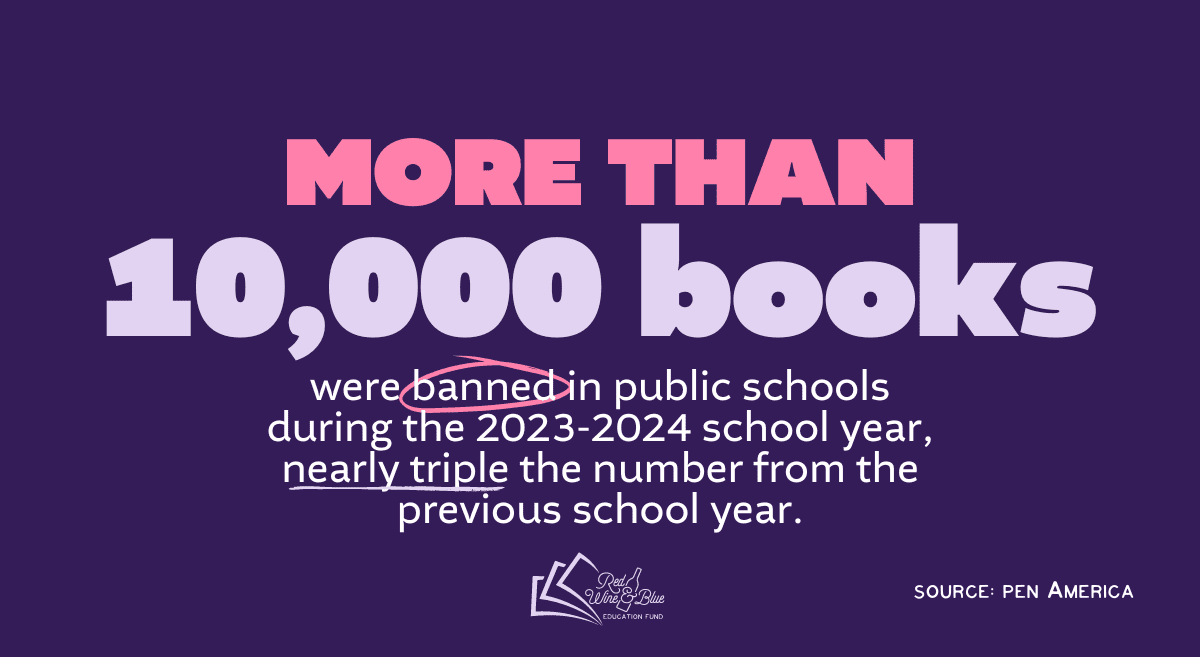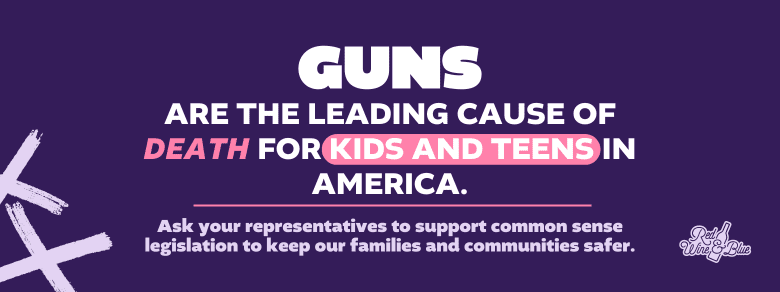
Hi there! Welcome to Easy A–Your go-to source for quick and easy actions you can take in five minutes or less about the issues you care about.
Are you a busy mom? Or maybe your work is so hectic you can’t think about anything else during the day? A lot of us are also taking care of parents or other loved ones too, leaving little time for anything else.
The good news is that these are things you can do while you’re waiting in the school pick up line, on your lunch break, or even at your kid’s soccer practice – anywhere you happen to be! And you can easily share Easy A with your friends so they can be in the know, too! We’ll send you a new action to take every week–just one, we promise –and it will always be something you can do in five minutes or less. Ready to get started? Let’s go!
Read This: Celebrating 2025 Local Election Wins
Voters made a big statement this week: Common sense and human decency are still our values, and we’ll keep showing up to fight extremism head-on.
You’ve probably heard about some exciting election wins, including Virginia electing its first female governor, Abigail Spanberger, and New Jersey electing its first Democratic female governor, Mikie Sherrill. Virginia also chose Ghazala Hashmi as their lieutenant governor, making her the first Muslim woman to be elected to a statewide office anywhere in the U.S.
There were also big wins that will help protect democracy against extremism, like Pennsylvania retaining three state supreme court judges, California passing Prop 50 to fight congressional gerrymandering, and Maine blocking an attempt to restrict their absentee voting.
But let’s also look at some local wins you might not be hearing about, and how voters made a powerful impact in our communities:
- Mary Sheffield was elected as the first woman mayor of Detroit, Michigan.
- Our Suburban Women Problem podcast host Amanda Weinstein won her city council race in Hudson, Ohio.
- 15 Red Wine & Blue members won various local races in North Carolina.
- In the town of Midland, NC, Isaac Davis was elected to the town council by a huge margin – becoming the first Black person to be elected to any position in the town.
- In Bucks County, Pennsylvania, which was ground zero for extremist takeovers of school boards back in 2023, the Central Bucks and Pennridge boards were flipped back to commonsense candidates.
- Despite extremists pushing their anti-trans agenda in Virginia, two candidates who will protect trans students – Ross Svenson and Monique Bryant – were elected to school boards in Loudoun and Arlington Counties.
- Ohio also saw commonsense school board candidates beat extremists in Trump-supporting places like Geauga County and Mentor, North Royalton, and Brecksville–Broadview Heights.
- Almost 78% of the school bonds and millages we supported in Michigan passed.
And these are just a handful of the stories we’re hearing!
These wins mean that in these communities, more people will see themselves reflected in their local leadership. Public schools will get the funding they need. Books will stay on classroom and library shelves. Teachers will be free to teach honest and accurate lessons. LGBTQ+ students will feel welcome and supported.
We know about these inspiring, local stories because of our amazing members working on the ground with us year-round in your own communities. You helped make them happen and we thank you for being with us. Take this moment to celebrate these victories and stay tuned – next week we’ll celebrate some more local wins as the stories keep rolling in!
P.S. If you have a little extra time tonight, join us for our virtual RWB Family Meeting to unpack election results and talk about what comes next. You’ll be the first to hear more stories like these from some of the most consequential local races in the country. Grab your bevvie of choice, get comfy, and log in to spend time with the RWB family! If you can’t make it, register anyway and you’ll be emailed the recording to watch when you have time.
Watch This: The Growing Movement to Ban Books
As instances of book bans continue to skyrocket year over year, it’s important to know that they overwhelmingly target stories about people or characters from marginalized groups.
According to PEN America, from 2021-2023:
- 37% of all book bans targeted books about race, racism, or books with characters of color;
- 36% targeted books with LGBTQ+ characters and themes; 8% featuring transgender characters or stories.
We read last week about how diversity in books is invaluable to students. Now hear more about this from someone who knows firsthand.
Ellen Oh is an author and founding member of We Need Diverse Books, a nonprofit that strives to diversify the publishing industry. Their goal is to create a world where everyone can find themselves in the pages of a book. Ellen tells us why this is so important — even life-saving.
We Need Diverse Books has helped fuel an increase in new children’s books featuring characters of color. Twelve years ago, only 7% of children’s books published were about children of color. Now that figure is 40%. As we celebrate this, we also have to protect these stories from becoming the next targets of book bans. Next week, we’ll tell you how!
Read This: The Growing Movement to Ban Books

It’s Banned Books Week! Since 1982, this annual event supports our freedom to read and brings attention to the growing movement to ban books. So, let’s talk about the increase in book bans and why it’s so important for us to push back.
Book bans have been around for centuries. They started when governments and religious institutions wanted to censor what they saw as threats to their authority or moral standing. We’re now seeing everyday citizens challenge our access to books in schools and public libraries, and those bans are increasing rapidly.
These modern book bans are defined as when, for any period of time, a student’s access to a book is restricted or completely prohibited. PEN America has been tracking the increase in book bans since 2021. Their latest research found that there were more than 10,000 instances of book bans in the 2023-2024 school year, which is almost triple the number in the previous year!
These recent book bans are being driven by extremist groups like Moms for Liberty. They are targeting what they consider to be controversial or objectionable content, which is usually books with LGBTQ+ or non-white characters, histories of minorities, religious or political viewpoints different from their own, or sex education. “Controversial” and “objectionable” to them is really just code for ideas and viewpoints they don’t like or don’t understand, and often involves marginalized communities. When extremists are successful in getting these stories and narratives banned, they are unjustly erasing the voices and representation of entire groups of people. That erasure has very real consequences for all children.
Book bans narrow our children’s worldview by taking away their exposure to stories about other people and places. It keeps them from exploring ideas and perspectives that are different from their own, which hinders their ability to build empathy. Book bans also teach them that it’s ok to hate and censor things you don’t agree with.
For kids in the communities whose stories are being banned, it hurts even more. When kids don’t see themselves represented, they think their stories are not worthy of being told. And when they see them banned, they think their stories are shameful. All kids deserve to see themselves and relatable characters in stories to know that they are valued and are not alone.
There’s also a financial cost to all these book bans. When books are challenged, most school districts and public libraries have a process in place to review the books and rule on the challenges. That takes extra staffing and personnel hours. For example, last year in Texas, Virginia, and Pennsylvania, school districts reported spending between $30,000-$100,000 and hundreds of full-time staff hours reviewing book ban attempts! There are better ways for this taxpayer money to be spent and for these professionals to spend their time.
All this harm is being caused by a loud but small group of people. The majority of us — more than 80% — don’t want book bans, so we also have to be loud and push back. Over the next few weeks, we’ll explore how to put a stop to this increasing trend of book bans before it gets any worse.
Do This: Preventing Gun Violence
Over the past few weeks, we’ve been discussing gun violence in America. And in just that short period of time, our country has been rocked by another mass shooting at a high school and a second alleged assassination attempt on a former president. It is clear that gun violence is a nonpartisan issue — and one that threatens us all.
So how do we make our families and communities safer? Experts have shown that there are ways to reduce gun violence: requiring background checks on all gun sales; promoting the secure storage of guns; allowing for Extreme Risk Protection Orders (also known as Red Flag Laws); keeping guns out of the hands of domestic abusers and violent offenders; and supporting programs for mental health and community violence intervention. We just need politicians who are willing to turn these common sense solutions into laws!
And here’s something you can do right now in under five minutes — Tell your Senators and Congressperson to support common sense legislation to reduce gun violence. We’ve made it easy for you. Start by filling out the form directly below — or at this link — and our tool will walk you through the rest. We’ve even written a message you can use or customize to your liking.
Nothing will change until our laws do, so your representatives need to hear from you! Be a part of the solution and send your message today.

Watch This: Preventing Gun Violence
According to research by Everytown For Gun Safety, 59% of adults in America have personally experienced gun violence, or know someone who has.
Gun violence includes mass shootings, homicides, assaults, suicides and suicide attempts, domestic violence, unintentional shootings, intimidation, threats, and more. Anyone who lives through these experiences, either as a victim, witness, or loved one to those involved, is a survivor.
Understanding the lifelong physical, mental, and financial toll of surviving gun violence is an important part of finding solutions to the crisis. We can better understand the toll by listening to survivors’ stories.
Greg Jackson, Deputy Director of the White House Office of Gun Violence Prevention, recently shared his survivor story on The Suburban Women Problem podcast. Watch:
Greg succinctly described some of the hard questions we have to face as a country to solve our gun violence crisis. Next week, we’ll have some answers to those questions, and an easy action you can take to be a part of the solution.
Read This: Preventing Gun Violence
Our hearts are breaking with the families of Apalachee High School in Winder, Georgia today as they grieve in the aftermath of a tragic mass shooting. Every day, more than 120 Americans are killed with guns and more than 200 are shot and wounded.1 Yesterday, at least four of those killed and nine of those injured were at Apalachee High School. We can’t stop thinking about them.
Guns are the leading cause of death for American children and teens.2 It’s a shocking statistic and a uniquely American problem. How much of this can our hearts take? Most of us agree, we can’t let this stand.
The term “gun violence” quickly brings to mind the horrors of mass shootings in our communities and schools like Apalachee, but it also includes other violent crime, domestic violence, suicide, and unintentional shootings. Gun violence can impact any of us anywhere at any time.
That’s why the majority of Americans, regardless of political party or whether they own a gun or not, support policies that help reduce gun violence.3 We all want to keep our families and our communities safe.
To do so, we need a wide range of solutions to tackle every cause of gun violence. To that end, the Biden-Harris administration has invested $30 billion in gun violence prevention efforts and have already:
- Passed the Bipartisan Safer Communities Act (BSCA), the most significant gun violence prevention legislation in 30 years.
- Signed dozens of executive orders that address both the supply of guns and the behavioral causes of gun violence.
- Created the first ever White House Office of Gun Violence Prevention (OGVP), overseen by Vice President Kamala Harris.
The Suburban Women Problem podcast recently spoke with the OGVP’s director, Stefanie Feldman, and deputy director, Greg Jackson, who told us just some of the things these historic efforts are accomplishing so far:
- Promoting and incentivizing secure gun storage. Secure storage is vital to protecting our families because:
- 30 million children live in homes with firearms in the U.S. – nearly 5 million of those in homes where guns are loaded and unlocked.4
- 76% of school shootings are committed with guns from the shooter’s home.5
- 80% of youth suicides by gun are committed using guns from the home.5
- 76% of unintentional shootings of children are committed using unsecured guns found in homes.5
- Providing resources and funding to schools for youth mental health initiatives through the Stop School Violence Act, the American Rescue Plan and the BSCA.
- Expanding the federal definition of who is a gun dealer. Now, previously unlicensed private sellers (online and at gun shows) have to get licensed like traditional gun stores and conduct background checks on gun buyers. This is the largest expansion of the background check system in 30 years and is keeping guns out of the hands of youth, felons, domestic abusers, and other people who may be a risk to themselves or others.
- Creating the Safer States Agenda for state legislatures which outlines 15 different measures individual states can take to reduce gun violence — measures like Extreme Risk Protection Orders (ERPO), also known as “red flag” laws — and providing model legislation for states to use.
This is only the beginning of the bipartisan, common sense work that can be done to reduce gun violence. We obviously need more solutions to help make our kids, families, and communities safer. We owe it to the victims and survivors of yesterday’s horrific mass shooting at Apalachee High School to keep this momentum going to prevent future tragedies.
- Gun Violence in America, Everytown, May 7, 2024.
- Firearms are the leading cause of death for American children and teens, Everytown, May 7, 2024.
- National Survey of Gun Policy, 2023 Results, Johns Hopkins Bloomberg School of Public Health, Center for Gun Violence Solutions, July 21, 2023.
- Unintentional Firearm Injury Deaths Among Children and Adolescents Aged 0–17 Years — National Violent Death Reporting System, United States, 2003–2021, CDC, December 15, 2023.
- White House Announces New Actions to Promote Safe Storage of Firearms, whitehouse.gov, January 25,2024.
Do This: Momonomics
It’s no surprise to us that, according to a July 2024 KFF survey, half of women voters “worry a lot” about being able to afford food and groceries.
 That means many women you know have this issue on their mind — and it’s likely to be a factor when they decide who they are voting for in this election. So now that you know some Momonomics, your friends need to hear from you!
That means many women you know have this issue on their mind — and it’s likely to be a factor when they decide who they are voting for in this election. So now that you know some Momonomics, your friends need to hear from you!
Remember that video we watched last week? We’ve made it — and other Momonomics content — super easy to share with your friends and family right now. Just select the post you want to share from below, and which social media platform you want to use, then follow the prompts to share with your network in just a few clicks!
And remember, Momonomics is for everyone. You can bust myths and counter disinformation by spreading the facts about the economy with everyone you know! Easy, right?
Watch This: Momonomics
In the past few weeks, Senator Elizabeth Warren joined us to discuss the economic threat of Project 2025, and financial advisor Shereen Boyer joined us for an “Ask Me Anything” event about the economy. More than 12,000 of you showed up for these two events! Wow.
We know how beloved these esteemed guests are, but this level of energy and attendance also proves something else we know — the economy is top of mind for suburban women.
We got rave reviews from both events because Shereen and Sen. Warren shared helpful, factual information about the current state of our economy in easy to understand ways. They also talked about what policy makers can do to improve the financial conditions of average Americans.
For example, watch this one-minute video of Shereen Boyer explaining why we are still seeing high prices for everyday goods like groceries, and how government policies could help us address the issue.
This is what Momonomics is all about! Giving you all the information you need to confidently talk about the economy with your friends and family.
If you’d like to dig in deeper to this week’s Easy A, you can find the full recordings of both recent events in our Momonomics playlist on our YouTube channel. Next week, we’ll help you share this important information with everyone you know!
Read This: Momonomics
We hear it from our community members all the time. Whether it’s an election year or not, the economy is top of mind for suburban women.
Of course it is! In many households, it’s the women who are making the day-to-day financial decisions. We’re doing the weekly shopping and all the budgeting and planning that comes with it. We’re keeping track of who needs what and when. From groceries to back-to-school shopping to veterinary visits to unexpected car or home repairs to knowing when there’s a little left to treat ourselves — no one manages money like modern suburban women.
But we also have questions. We hear the economy is doing well, so why are everyday goods and services still so expensive? Why is it so hard to find affordable housing? When will we ever pay off these student loans? What even is inflation?!
That’s why Red Wine and Blue launched Momonomics! Mononomics is our movement of mainstream suburban women who want the facts on the economy, not some partisan talking points.
You don’t have to be a mom to love Momonomics. Some of us are moms to kids, some of us are moms to dogs, some of us are moms to our communities, some of us are “childless cat ladies,” and many of us don’t consider ourselves moms at all. This campaign is for EVERYONE who believes our government should work for all families — no matter what they look like.
We’re providing tools and shareable content to help women confidently talk about things like inflation, childcare costs, rising housing costs, student loan debt, medical expenses, caring for our aging parents, and more.
For example, check out this carousel where we’re providing FACTS to counter some common economic myths that frequently circulate online. You can bookmark our Momonomics webpage for more content like this in the future, and stay tuned for next week’s Easy A to learn more!
Do This: PragerU: Coming To A School Near You
Now that you know about the extreme-right ideology being taught in public schools using PragerU materials, you’re probably wondering what you can do to stop it.
Whether you’re in one of the four states that approved PragerU (Florida, Montana, New Hampshire, and Oklahoma) or you’re trying to keep your state from becoming the next one on that list, the good news is, there are things you can do. Communities are pushing back on this kind of extremism in schools, and they’re winning!
For example, last year in the Pennridge School District in Bucks County, Pennsylvania, a local group called the RIDGE Network successfully activated community members to defeat extremism. Laura Foster, co-founder of RIDGE Network explained how they did it on our Cost Of Extremism podcast episode about PragerU (season 2, episode 3).
Extremists held a majority of seats on the Pennridge School Board, and they secretly arranged to contract with Vermillion Education — a group similar to PragerU — for curriculum. Under the extremist majority, students were subjected to whitewashed history and other inaccurate lessons. But after the RIDGE Network and other community members organized and turned out voters in the 2023 elections, five open seats on the Pennridge School Board were won by common-sense candidates who oppose extremism, and the contract with Vermillion was canceled.
Here’s what Laura and other experts recommend you do to effectively fight extremism in schools:
- Regularly talk with teachers and school administrators. This is how you learn what is going on at school, and how you let them know you’ve got their back.
- Volunteer in your local school(s).
- Go to school board meetings.
- Have conversations with people in your community about your schools. Many of us are busy and just assume everything is okay unless we hear otherwise, so let people know what is going on.
- Get parents involved. Ask everyone you know who cares about your schools to join you in supporting them.
- Be the biggest cheerleader for schools in your community. Promote school activities and showcase the hard work educators are doing everyday to help children become well-educated, better citizens.
Download our Parent Playbook for even more ways to keep extremist BS out of your local schools.
With these actions and our Playbook in hand, you’ll be ready to defeat extremism — like that of PragerU — if it ever shows up in your local schools!
Watch This: PragerU: Coming To A School Near You
Last week, we shared some examples of PragerU videos that are being shown to children in public school classrooms in the U.S. They may have seemed too extreme to believe, so this week, we want you to see for yourself!
Watch this video where Jo from Red Wine and Blue pokes a little fun at some clips from PragerU videos, but seriously explains the threat they pose to our kids’ education.
Next week, we’ll talk about how to keep PragerU (and other extreme companies like them) from becoming part of the curriculum in your local schools.







